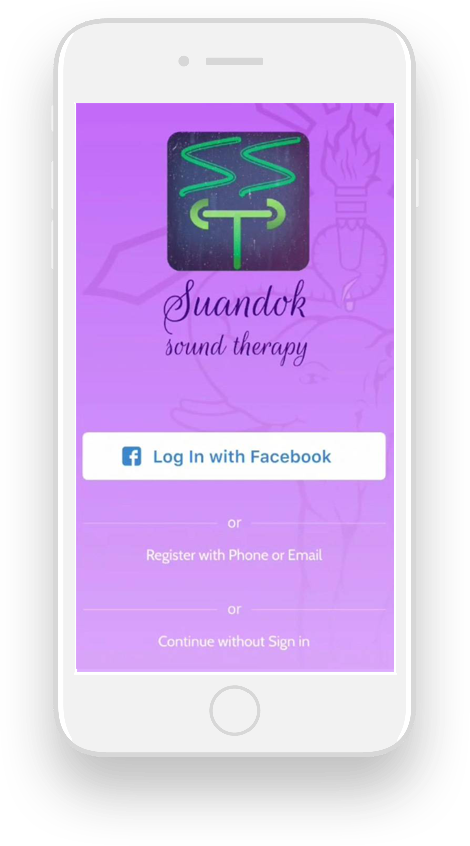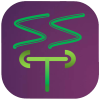About Our App
SUANDOK SOUND THERAPY (SST) Application
Suandok Sound Therapy (SST) app is an innovative application for emotional therapy and healing through the usage of various and comprehensive components and forms of sound and music, including binaural beats, isochronic tones, superimposed binaural beats, natural sounds, noises, ASMR and voices. The superimposed binaural beat is a new sound frequency unprecedentedly invented by Assoc. Prof. Jakkrit Klaphajone, M.D., via a different synthesis mechanism. Instead of constant carrier sound frequencies, which are used by the conventional binaural beat synthesis, the fluctuating carrier sound frequencies are used and vary over time but the resultant beats still remain constant between each ear. A preliminary research study revealed that this new mechanism is more effective in reducing anxiety than the conventional binaural beats.
SST application can be easily customized for each user and is specifically designed to help individuals with stress, anxiety, depression, concentration problems, confusion, drowsiness, or insomnia. SST app can also complement mental and physical activities, such as meditation and exercises.
Precautions:
People who suffer from seizures, severe heart problems, or uncontrolled schizophrenia should not listen to binaural beats, superimposed binaural beats or isochronic tones as these sounds might worsen the symptoms.


Theory, hypothesis and concepts of therapeutic sounds
Normally, human brainwaves are in different patterns which be recognized by their amplitudes and frequencies. Brainwaves can then be categorized based on their level of activity or frequency into 4 levels which are beta wave, alpha wave, theta wave, and delta wave. These brainwaves are detectable on specific parts of the scalp, corresponding to the parts of the brain just below. The brain has many specialized regions which correspond to different processes, thoughts, and sensations. Particular brainwaves often reflect distinct regions and networks in the brain communicating with each other.
Research has revealed that alpha wave has something to do with pain perception as people with chronic pain seems to have reduced alpha wave proportion. Alpha brainwave entrainment has been confirmed by previous studies for pain modulation in patients undergoing gastrointestinal endoscopy.

Brainwave entrainment refers to a process of the brain to naturally synchronize its brainwave frequencies with the rhythm of periodic external stimuli, most commonly auditory, visual, or tactile. Commonly used auditory stimuli include isochronic tones, monaural beats and binaural beats or a combination of sounds and lights (audiovisual stimulation). Binaural beats are mostly applied and generated with the different frequencies of carrier sounds between 2 ears. Parts of the sounds are also believed to be travelled via bone conduction. The interference of bilateral sounds is then perceived or possibly neurally propagates with resultant beats from the brainstem up to higher brain regions causing frequency following response leading to certain activity changes.

History of binaural beats
The application of binaural beat was originally discovered in 1839 by physicist Heinrich Wilhelm Dove. He discovered when carrier sounds of two slightly different frequencies are presented separately, one to each ear, the brain detects the phase variation between the frequencies and tries to reconcile that difference. If the left ear hears a sound with the frequency of 305 Hz and the right does with 295 Hz, the resultant beat generated in the brain is 10 Hz (as shown in the diagram).
Available forms and elements of sounds in SST app
About Suandok Sound Therapy (SST) Application
Binaural beats (BB)
A binaural beat is the sound frequency created by presenting two carrier sounds, whose frequencies are constant but not much different from each other, to stimulate each ear separately or through the skull. The resultant frequency then interposes and induces the brainwaves in various parts of the brain. The binaural beats therapy is most effective when listened through stereo headphones. The therapy is ideal for promoting concentration, relieving stress or anxiety, and improving sleep quality.
Isochronic tones (IT)
An isochronic tone is a sound frequency simulating an interference of two similar frequencies. The periods of amplitude changes are identical on both sides; therefore, unlike the binaural beats, this form of therapy does not require stereo headphones. The therapeutic effects are comparable to those of the binaural beats.
Superimposed binaural beats (SBB)
The superimposed binaural beat is a new sound frequency unprecedentedly invented by Assoc. Prof. Jakkrit Klaphajone, M.D., via a different synthesis mechanism. Instead of constant carrier sound frequencies, which are used by the conventional binaural beat synthesis, the fluctuating carrier sound frequencies are used and vary over time but the resultant beats still remain constant between each ear. A preliminary research study revealed that this new mechanism is more effective in reducing anxiety than the conventional binaural beats.
High frequency soundwaves (HF)
High frequency soundwaves are widely used to achieve the high frequency sound masking for the therapy of tinnitus
Autonomous sensory meridian response (ASMR)
ASMR sounds are utilized in stimulating the autonomous sensory response of the nervous system. The sounds are characterized by their clearness and sharpness. The intensity of sounds constantly shifts between left and right ears, thus, mimicking sounds in daily life, such as chewing sounds, conversations, whispers, sounds of surrounding, object handling and tapping, etc. These sounds can trigger sensation of past experience variously perceived by each individual. There are also accepted research papers confirming the sleep-inducing capability of ASMR sounds.
Heartbeats sounds (HB)
Heartbeat is one of the natural sounds that can effectively stimulate our emotion and feeling. It is the very first sound a human perceives when inside the mother’s womb. Different heartbeat periods have different effects from inducing relaxation to promoting anxiety.
Noises
Noises are an aggregation of sounds in all frequency ranges, useful for sound masking, performance sound check, and psychoacoustic therapy. SST app is offering three noise features.
7.1. White Noise (WN) (similar to white light, which contains an equal intensity among all frequency ranges)
White noise is a random sound frequency encompassing the entire range of the human audio spectrum and having equal intensity in all frequency ranges. This noise is very similar to the static sound from a radio or a television. White noise is often used to mask other disturbing sounds during a sleep or a meditation session. Because human’s concentration can be easily disrupted when there is a rapid fluctuation of sound frequencies, the use of continuous and little fluctuating noises can help mask the trigger from the surrounding and is also popular in the treatment of tinnitus.
7.2. Pink Noise (PN) (similar to pink light, whose low frequencies are having high intensity)
Pink noise contains power spectrum intensity that is inversely proportional to frequency (that is, the intensity decreases with higher frequencies). The sound of pink noise resembles the sounds of waterfalls or breezes. Like white noise, pink noise is effective in masking unwanted noises but is more soothing than white noise. Moreover, several research studies showed that pink noise, when listened in intervals during deep sleep, could lessen memory loss in those prone to amnesia.
7.3. Brown or Brownian Noise (BN) or Red Noise
Brown noise has lower intensity at high frequencies than pink noise. It is used to stimulate relaxation and meditation. The sound of brown noise is deepest or most low-pitched among all three types of noise.
Natural Sounds (NS)
Natural sounds can affect emotion and feelings in many different ways, depending on the listener’s experience. In general, natural sounds with a continuous pattern and random frequencies, such as the sounds of waterfalls, waves crashing on the beach, and rain, are often used as a stimulation for the relief of stress and anxiety, as well as the concentration or sleep improvement. The cricket chirping sound can help feel more at ease during the nighttime for the better sleep, while the sounds of birds or other animals, which have random intervals and irregular periods, can arouse alertness and liveliness. Moreover, the sound of flowing water with regular changes in frequencies and volume during a certain period can help increase concentration and aid during a meditation.
Music
Components of music in healing, therapy, and improvement of body, mind, emotion, and behaviors are followed.
9.1. Melody
Melody is a group of sounds forming an identity of music. It is arranged from creativity, inspiration, or a drive of the composer. The melody in minor keys is often used to stimulate a feeling of sorrow or content, while major keys are to trigger joy and elation or to ease dejection.
9.2. Tone or Timbre
Tone or timbre is a specific quality of sound caused by the vibration of a material, generally from string instruments, wind instruments, and percussion instruments, such as violin, piano, drum, etc. Sounds from percussion instruments can induce alertness, while string instruments can help reduce stress and develop steady emotion according to the continuing duration of the sound.
9.3. Pitch
The high or low pitch level depends on the frequency of the cycle of vibration. The high number of cycles causes a high pitch, which can stimulate alertness, while a low pitch can help with calmness and relaxation.
9.4. Volume or Intensity
Volume or intensity depends on the loudness of sound, which in turn is directly proportional to the magnitude of vibration. High volume is utilized when attention or alertness is needed, while low volume is used toward relaxation.
9.5. Rhythm
Rhythm is the length of sounds, which when combined together help generate a melody. Rhythm can reflect a variety of feelings. The definition of rhythm also includes the rhythm created by percussion instruments. A constant rhythm can become familiarized by the nervous system but does not stimulate well, unlike a nonconstant rhythm, which is better at gaining attention and response from the body.
9.6. Tempo
Tempo is the rate of speed of a musical piece. A musical composition can contain many different tempos. High tempo can cause stimulation and alertness, while low tempo can induce relaxation, stress relief, and sleep.
9.7. Harmony
Harmony is generated from a combination of melodies and different forms of sounds, thus, creating many different musical genres. Different genres affect emotion and feeling in different ways. Jazz harmony helps increase sound perception and shift emotion. The harmony from diminished chords can induce fear and worries, while that of augmented chords can lead to skepticism or suspense feeling.
Voices
Voices are referred to sounds made when humans speak or sing. Voices can be applied with the other sounds to enhance the desired effects or to guide each therapeutic method. Four types of voices are included in SST application.
10.1. Subliminal Messages (SM)
Subliminal messages are auditory or visual messages presented at levels that are below normal perception. Previous studies revealed that subliminal messages had the potential to influence the mental states both consciously and subconsciously.
10.2. Hypnotic Suggestions (HS)
Mental states can be altered through hypnotic suggestions with normal speaking voices, monotonous voices, or whispers.
10.3. Chanting (CH)
Chanting is an iterative speaking or singing of words or sounds, often primarily on one or two main pitches (reciting tones). In Buddhism, chanting is the traditional means of preparing the mind for meditation.
10.4. Guiding Voices (GV)
For breath work or exercise purposes, some guiding or encouraging voices are provided for the maximum effects of boosting energy, improving exercise duration, stimulating muscle exertion or concentration.
It is important to consider these elements of sounds and carefully choose the right sounds, voices and music for each therapeutic purpose. According to the "Iso principle" in music therapy, it is recommended to begin with the sounds and music conforming to the initial state of mind and then slowly shift the musical components and sound elements to achieve the desired effect.

